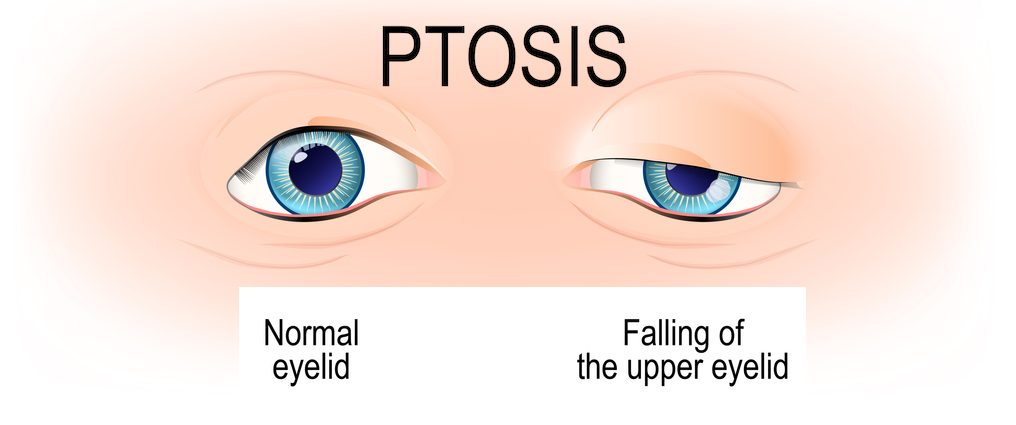Droopy eyelid also known as ptosis, which is a term to describe the appearance of the upper eyelid when the eyelid lash margin is a constantly at a lower level than what is normally expected

Fortunately, Plastic surgery of the eyelids (blepharoplasty) can correct droopy eyelids (ptosis) by tightening the overstretched levator muscle and removal of excess skin above the eyes. There are no non-surgical options such as injections, skin tightening devices that can address droopy eyelids.
Droopy eyelid surgery or correction of eyelid ptosis is mainly functional because it improves the visual field and symptoms such as headaches, heaviness of the eyes.
Droopy eyelid (Ptosis) surgery has functional and medical benefits as it improves vision and practice of daily life activities,.
Droopy eyelid (ptosis) surgery is performed in a licensed facility and usually takes 2 hours, but this can vary from patient to patient depending on the additional procedures performed.
Healing and recovery vary from patient to patient but on average, the healing process takes two (2) weeks or more. Please ensure you allow adequate healing time after eyelid surgery and follow all the helpful healing instructions and don’t try to do too much too soon; you will need to rest your eyes a lot during those 2 or more weeks of healing.
Most droopy eyelid surgery or ptosis correction procedures are very complex operations requiring technical expertise and aesthetic finesse. That’s why it’s so important to choose a Specialist Plastic Surgeon, who has had extensive training and experience in eyelid surgery.
OUR PROCESS
You will generally see Dr Somia 3 times before your surgery. If you prefer one of these consultations can be held via telehealth. Two consultations are required by law before a date for surgery is scheduled. This is to allow you plenty of time to ask questions and feel comfortable about the procedure. Your third consultation will assist us to prepare you for your surgery (ie paperwork, pre-operative testing).
PROCEDURE DETAILS
The surgery takes approximately 1.5 hours to 2.5 hours depending on the procedure recommended and requires an overnight stay in hospital. Our fees include specialist plastic surgeon, specialist anaesthetist, fully accredited hospital theatre, accommodation and 6 months aftercare. A formal estimate will be provided after you have discussed your goals and what is possible to achieve them with Dr Somia.
RECOVERY
Each patient recovers at a different rate and anothers recovery should not be compared with yours.
Generally, initial recovery from swelling and bruising is approximately 3-4 weeks. A return to normal activities can usually be expected after 6 weeks. Full results can be expected 3-6 months after.
You can return to work when you feel well and if your employer has lighter duties for you and will allow you to take time to rest and move around. Most patients take 2-3 weeks off work if they work in an office context. Patients working outdoors or in a physical capacity may need to take up to 6 weeks off work whilst they recover. Talk to us about your specific occupation and surgery.
You can drive when the anaesthetic has worn off, your vision is clear, and you are pain free getting in and out of the care and whilst performing an emergency stop. You should check your vehicle insurance policy for their requirements in this situation.
RISKS
All surgery carries risks. When travelling overseas on a plane whilst the expectation is a safe journey and arrival, it is understood things could go wrong. The choice of the airline based on safety record and flight path are important elements in determining risk. Similarly, for your surgery, the experience and expertise of your Surgeon, the skill of your anaesthetist and the standard of the hospital will determine the risk. Risks, both general and specific, will be discussed during your consultations and written information will be provided for you to take home.
General risks include pneumonia, deep venous thrombosis and pulmonary embolism, stroke, heart attack, allergies, awareness, death, bleeding, infection, sensation change, haematoma and seroma, skin contour irregularities, damage to deeper structures, firmness, delayed healing and tissue death, exposed sutures, dog ears or additional skin golds, dressing issues, asymmetry, scars, lymphoedema and unsatisfactory results.
Risks specific to Blepharoplasty (Eyelid) surgery are: injury to the eye globe, need for extra tissue, loss of vision, changes to tear secretion, conjunctival oedema and chemosis, exposed sutures, upper eyelid malposition, difficulty closing the upper eyelid and corneal exposure, lower eyelid malposition and eyelash loss.
BEFORE AND AFTER PHOTOGRAPHY
Our practice privacy policy prevents sharing patient before and afters online. Indicative before and after photos can be viewed during your consultation.
BONDI JUNCTION OR BELLA VISTA NORWEST
P 02 9387 2110
SMS 0483 939 962
SUBSCRIBE TO NAVEEN'S BLOG
Receive notifications new articles are published.
CONTACT
Bondi Junction
Westfield Tower 2,
Suite 1305, 101 Grafton St,
Bondi Junction NSW 2022
info@naveensomia.com.au
02 9387 2110 I 0438 939 962
CONTACT
Bella Vista
Suite 212, Level 2, 10 Norbrik Dr
Bella Vista NSW 2153
info@naveensomia.com.au
02 9387 2110 I 0438 939 962